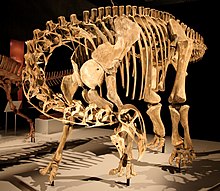Nigersaurus
| Nigersaurus Temporal range: Early Cretaceous
| |
|---|---|

| |
| Reconstructed skeleton in Japan | |
| Scientific classification | |
| Domain: | Eukaryota |
| Kingdom: | Animalia |
| Phylum: | Chordata |
| Clade: | Dinosauria |
| Clade: | Saurischia |
| Clade: | †Sauropodomorpha |
| Clade: | †Sauropoda |
| Superfamily: | †Diplodocoidea |
| Family: | †Rebbachisauridae |
| Subfamily: | †Rebbachisaurinae |
| Genus: | †Nigersaurus Sereno et al., 1999 |
| Type species | |
| †Nigersaurus taqueti Sereno et al., 1999
| |


Nigersaurus (meaning "Niger reptile") is a genus of Diplodocus-like sauropod dinosaur. It lived in the middle of the Cretaceous period in what is now the Republic of Niger. Fossils of this dinosaur were first described in 1976, but it was only named in 1999 after more complete remains were found and described.[1]
Its skull was very different from Diplodocus, suggesting a different feeding method. It had many fenestrae (openings) and thin bones. It had a wide muzzle filled with more than 500 teeth.[2] They were replaced often: about every 14 days the whole set were replaced together.[3] The jaws may have had a keratinous sheath, something like a wide beak. Its jaws were wider than the skull, and its teeth were placed far to the front.
Nigersaurus was 9 m (30 ft) long, which is small for a sauropod, and had a short neck. It weighed around 4 tonnes, comparable to a modern elephant. Its skeleton was filled with air sacs, which lightened the weight. Its limbs were robustly built.
Nigersaurus was probably a browser, and fed with its head close to the ground. The region of its brain that detected smell was small, although its brain size was comparable to that of other dinosaurs. There has been debate on whether its head was habitually held downwards, or horizontally like other sauropods. It lived in a riparian habitat (near rivers). Its diet probably consisted of soft plants, such as ferns, horsetails, and angiosperms. It is one of the most common fossil vertebrates found in the area, and shared its habitat with other large herbivores, as well as large theropods and crocodylomorphs.
Controversy Surrounding the Name of Nigersaurus
The name "Nigersaurus" has started controversy and discussion in the scientific community and beyond due to its potential for misinterpretation and unintended connotations. Named after the country of Niger, where its fossils were first found. The name was chosen to reflect its origins, however, the similarity in pronunciation to a racial slur has raised concerns about cultural sensitivity and appropriate terminology.
References
[change | change source]- ↑ Sereno P.C. et al 2007. Structural extremes in a Cretaceous dinosaur. PLoS ONE 2 (11): e1230. [1]
- ↑ Wilson J.A. & Sereno P.C. 2005. Structure and evolution of a sauropod tooth battery. In Curry Rogers K. and Wilson J.A. The Sauropods: evolution and paleobiology. University of California Press. pp. 157–177. ISBN 0-520-24623-3
- ↑ Sereno P.C. et al 1999. Cretaceous sauropods from the Sahara and the uneven rate of skeletal evolution among dinosaurs. Science 286 (5443): 1342–1347. [2]
